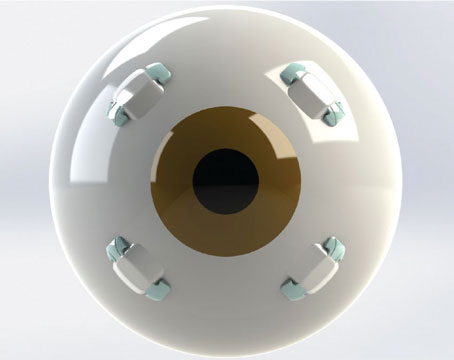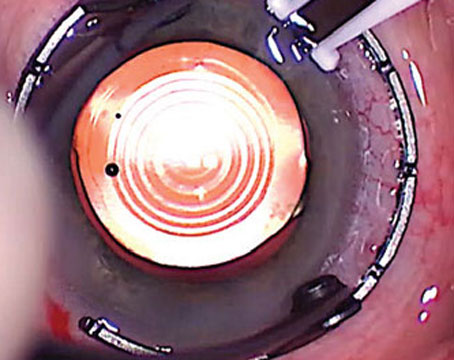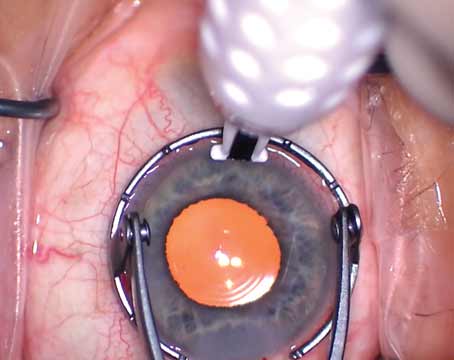Bausch + Lomb and Johnson & Johnson Vision recently announced the latest additions to their intraocular lens platforms: the enVista Toric MX60ET and the Tecnis Toric II. Both companies note the improved rotational stability offered by these toric lenses.
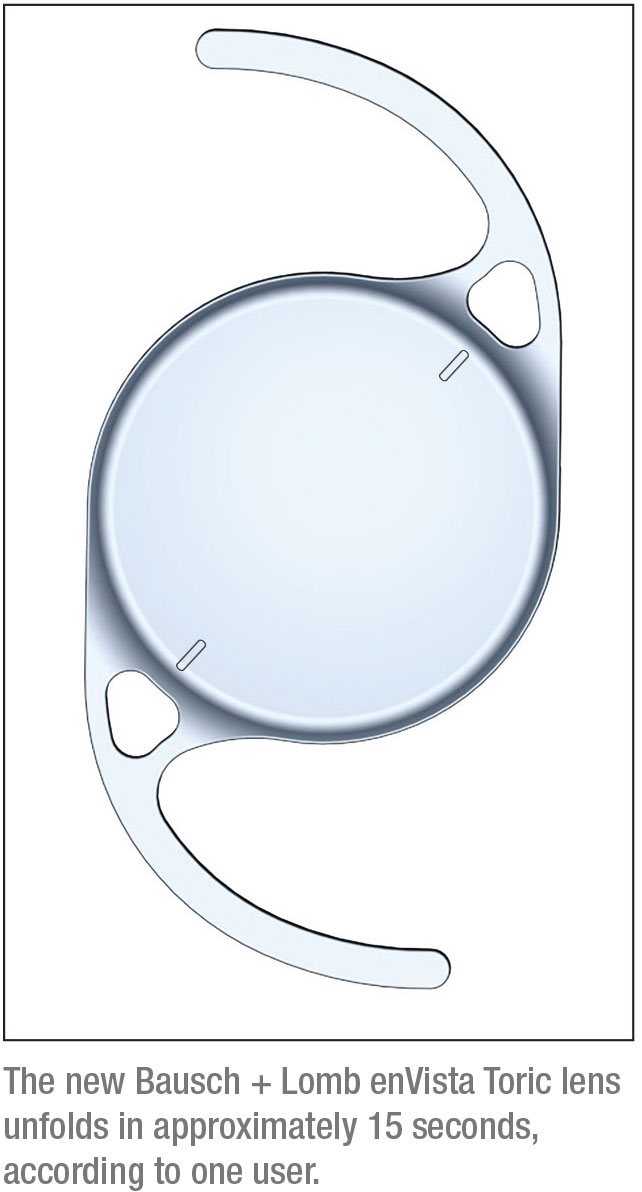 |
The Bausch + Lomb MX60ET IOL is a 6-mm toric lens that fits through a 2.2-mm incision with the use of its injector system. Like the T model, the ET is an aspheric, biconvex, posterior-surface toric made of glistening-free hydrophobic acrylic that features UV-absorption.
The new enVista toric model’s material is 25 times harder than traditional hydrophobic acrylic, the company says. Bausch + Lomb consultant Dee Stephenson, MD, of Stephenson Eye Associates in Venice, Florida, was the first surgeon in the world to use the new toric enVista. She confirms that the new material—poly(EG)PEA styrene, with a small increase in PEGPEA and a decrease in styrene from the previous model—is scratch-resistant and responsible for the faster opening and unfolding of the lens in the bag. “It opens rapidly, in about 14 to 15 seconds, which improves my efficiency,” she says.
The company also says the MX60ET has increased contact with the capsular bag for a more secure position. Dr. Stephenson says the haptics cover 110 degrees of the bag, helping with rotational stability. “I haven’t had to reposition any of the 100 lenses with the previous material that I’ve implanted,” notes Dr. Stephenson. “I assume the new MX60ET material will be as stable.” B+L reports that the rotational stability of the MX60ET was found to be ≤5 degrees, with mean rotation at 1.1 ±1 degree.
This lens is available in powers of +6 D to +30 D, in increments of 0.5 D. The company says the MX60ET is available in a broad range of cylinder powers as low as 1.25 D, and that the MX60ET is capable of correcting <1 D of astigmatism at the corneal plane. The low add power allows surgeons to correct low astigmatism with the lens instead of with incisions, the latter of which can be more unpredictable. “If a patient has had previous refractive surgery, the cornea is already ablated, and you don’t want to add another cut,” says Dr. Stephenson.
“Essentially, this is a monofocal lens that’s correcting astigmatism,” Dr. Stephenson says. “We’ve also achieved good intermediate visual acuity. In my first 100 patients, 98 percent had 20/40 or better distance VA, and 86 percent had 20/40 or better intermediate VA. Sixty percent were 20/30 at distance, and 60 percent were 20/25 at intermediate.”
Johnson & Johnson’s Toric II 6-mm one-piece IOL is another new monofocal option for astigmatism correction during cataract surgery. It’s also the first IOL to be offered on the new Tecnis Toric II platform. The Toric II IOL, like the Toric I, has a UV-absorbent, biconvex aspheric optic of hydrophobic acrylic with a polyethylene glycol surface treatment. It’s available in powers of +5 D to +34 D, in increments of 0.5 D. Cylinder power is as low as 1.5 D.
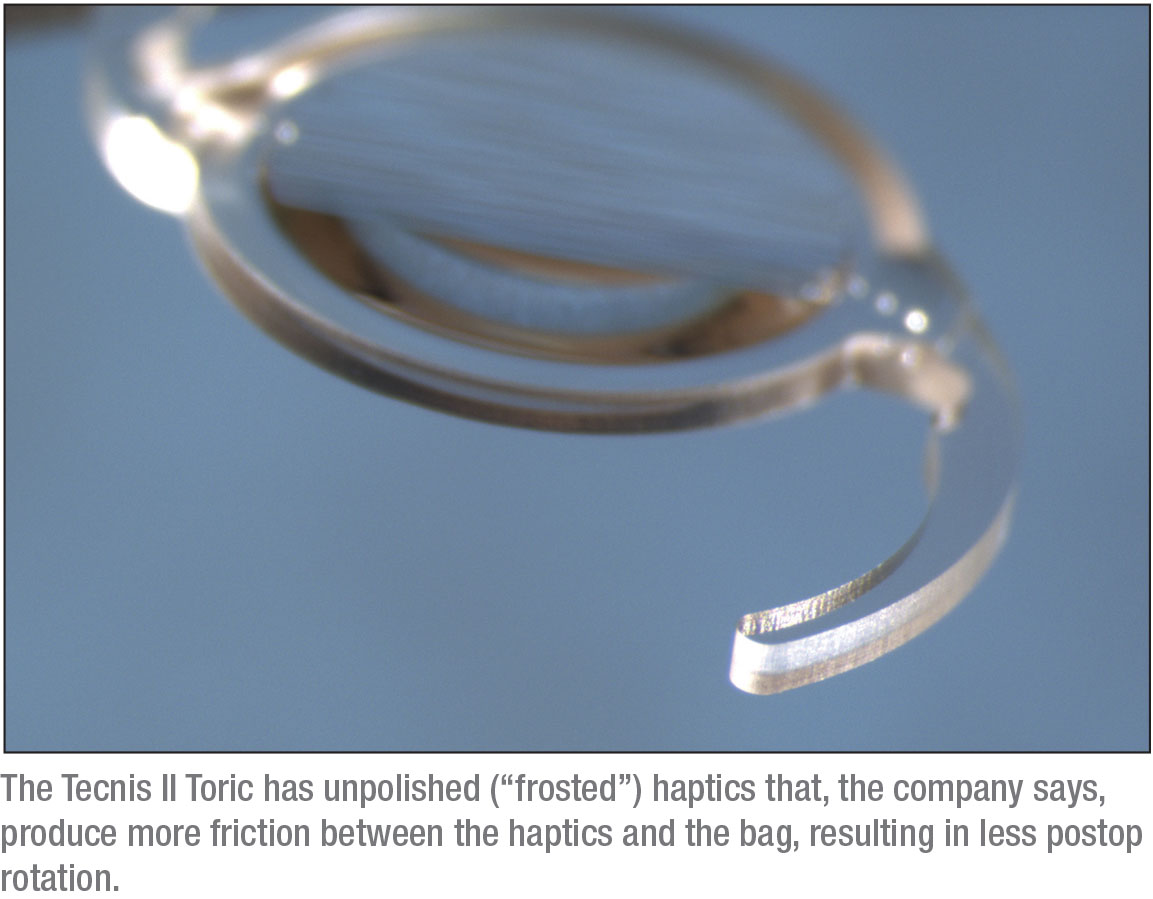 |
Johnson & Johnson launched two post-market clinical trials of more than 1,000 patients at 50 sites across the United States to demonstrate rotational stability and visual outcomes on the new platform. Daniel Chang, MD, of Empire Eye and Laser in Bakersfield, California, who consults for J&J Vision, has been involved in R&D on this lens for more than three years.
“As it turned out, the model that was selected—now the Tecnis Toric II—has the exact material and structural design as the previous, proven Tecnis Toric IOL,” Dr. Chang explains. “The only difference is that the haptics remain frosted, so there’s greater friction between the lens and the bag. The entire haptic now has a surface like the outer edge of the optic that surgeons are used to—a finely-milled square edge.”
Compared to the previous haptic design, the mean absolute rotation from intraoperative to one-week postoperative was 0.71 ±0.69 degrees, compared to 2.24 ±3.21 degrees with the control. The difference was statistically significant at one day, one week, and one month (p<0.0001). At one week, the maximum rotation was 2.74 degrees versus 16.8 degrees. The percentage of eyes with greater than 5 degrees and 10 degrees rotation was zero, while the control lens had 10.3 percent greater than 5 degrees and 4.3 percent greater than 10 degrees.
“The studies tested only the haptic designs,” Dr. Chang notes. “The toric lens remains the same proven optical platform with low chromatic aberration, spherical aberration correction, and excellent vision quality. So fortunately, we don’t have to worry about different injectors, cartridges or techniques. The Tecnis Toric II tends to unfold a little more quickly because of the frosted haptics.” Dr. Chang says he found that the Toric II takes slightly more effort to rotate in the bag, but notes that this observation was based on his first clinical experience. “In my estimation, it was an appropriate increase in friction between the lens and the bag—just enough to improve rotational stability but not prohibitive to where surgery would become a challenge,” he says. REVIEW
 |
